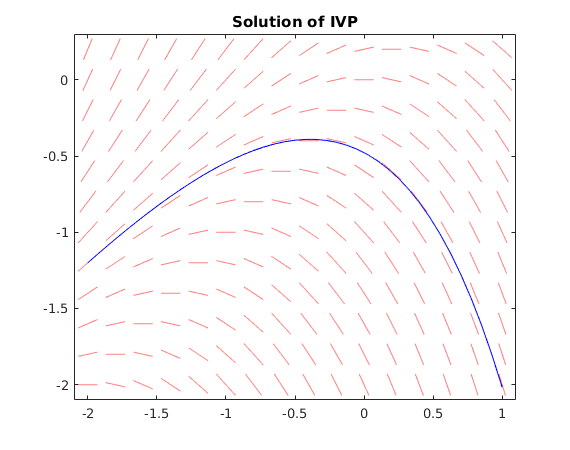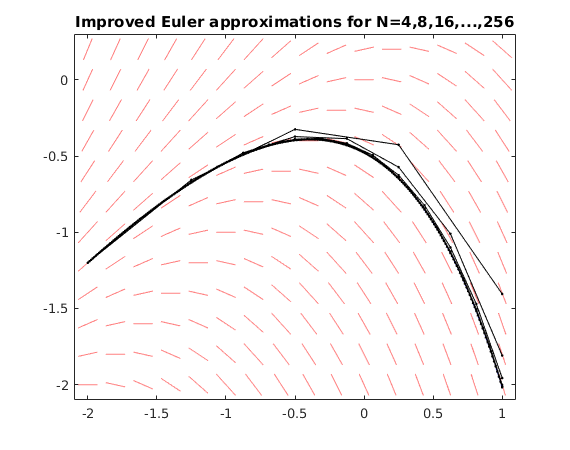Example for Improved Euler method (aka RK2 method)
Contents
You need to download an m-file
You have to download the m-file dirfield.m.
function Ieuler_demo
format short g
Initial value problem
We consider the initial value problem

and we want to find the solution y(t) for t in [-2,1].
We use ode45 to find the solution of the initial value problem and obtain the approximation -2.01711 for y(T).
We plot the solution together with the direction field.
f = @(t,y) y-t; % define function f(t,y) dirfield(f,-2:.2:1, -2:.2:0.2); hold on t0 = -2; y0 = -1.2; % initial point T = 1; % final t-value [ts,ys] = ode45(f,[t0,T],y0); % solve IVP yfinal = ys(end); % value for y at time T fprintf('y(T) = %g\n',yfinal) plot(ts,ys,'b') % plot solution title('Solution of IVP')
y(T) = -2.01711

Use Improved Euler method with N=4,8,16,...,256
We see that the Improved Euler approximations get closer to the correct value y(T)=-2.01711 as N increases. Note that the errors are much smaller than the errors for the Euler method.
When we double the value of N the error gets divided by about 4. This means that the error is bounded by  : The Improved Euler method converges with order
: The Improved Euler method converges with order  .
.
olderr = NaN; for N = 2.^(2:8) [ts,ys] = IEuler(f,[t0,T],y0,N); err = ys(end)-yfinal; % error fprintf('N = %3g, approx.for y(T) = %10g, error = %11g, quotient = %g\n',N,ys(end),err,olderr/err) olderr = err; plot(ts,ys,'k.-') % plot Euler solution end hold off title('Improved Euler approximations for N=4,8,16,...,256')
N = 4, approx.for y(T) = -1.40474, error = 0.612376, quotient = NaN N = 8, approx.for y(T) = -1.80824, error = 0.208874, quotient = 2.93179 N = 16, approx.for y(T) = -1.95615, error = 0.0609576, quotient = 3.42655 N = 32, approx.for y(T) = -2.00068, error = 0.0164295, quotient = 3.71025 N = 64, approx.for y(T) = -2.01285, error = 0.0042635, quotient = 3.85352 N = 128, approx.for y(T) = -2.01602, error = 0.00108866, quotient = 3.91629 N = 256, approx.for y(T) = -2.01683, error = 0.000278095, quotient = 3.91469

code of function IEuler(f,[t0,T],y0,N)
At each step we evaluate the slope twice: first at the current point, then at the Euler approximation. We then use the mean (s1+s2)/2 to find the new y value.
function [ts,ys] = IEuler(f,tv,y0,N); t0 = tv(1); T = tv(2); h = (T-t0)/N; % stepsize h ts = zeros(N+1,1); ys = zeros(N+1,1); t = t0; y = y0; % initial point ts(1) = t; ys(1) = y; for i=1:N s1 = f(t,y); % evaluate direction field at current point yE = y + s1*h; % find Euler value yE s2 = f(t+h,yE); % evaluate direction field at Euler point y = y + (s1+s2)/2*h; % use mean (s1+s2)/2 to find new y t = t + h; ts(i+1) = t; ys(i+1) = y; % store result in vectors ts,ys end end
end